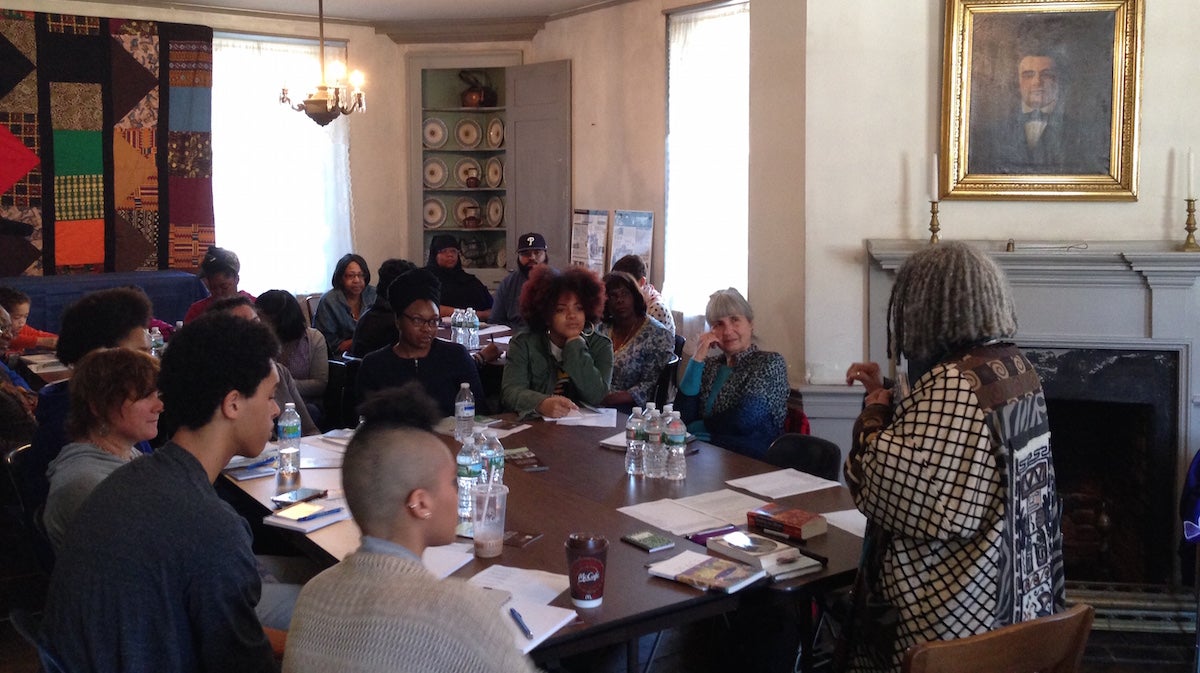Haiku workshop led by poet Sonia Sanchez explores social fabric of Northwest Philly

(Alaina Mabaso/for NewsWorks)
“I want to be five,” a little boy in the corner of the Johnson House room announced, by way of introduction.
That is an excellent first line for a haiku, poet Sonia Sanchez told the giggling crowd at her Haiku Trail to Freedom workshop.
“Write it down,” she urged, scrawling the line herself atop a large pad of paper on an easel. Every time you hear something surprising, or something that gets a reaction from the people around you, write it down: you never know what could grow out of it.
The Haiku Trail to Freedom workshop was part of Historic Germantown’s Elephants on the Avenue: Race, Class and Community in Historic Germantown project, featuring two years of free events and workshops in the neighborhood, joining artists and historians with the public to explore Northwest Philly’s past and present social fabric.
The program is “opening up a platform to have a dialogue on race and class and what that means,” said Trapeta Mayson, executive director of Historic Germantown, in her introduction to a group of about 25 practicing and aspiring writers of all ages who packed the front room at Johnson House on Saturday.
Sanchez is the author of 16 books and a former Temple University professor who has spent decades as an international activist and scholar while calling Germantown home for the last 40 years. She has received the Robert Frost Medal for distinguished lifetime service to American poetry, the Langston Hughes Poetry Award, and was named Philadelphia’s first poet laureate.
“Every morning I write a morning haiku. It’s a mantra…There is no violence in a haiku,” Sanchez said of the art form, which she calls “preserved breath,” memoirs that “remind us of the fragility of memory.”
Let me wear the day
Well so when it reaches you
You will enjoy it
She shared the above poem, which she penned during a 1973 trip to China, playing on the idea of spreading interpersonal peace alongside the fact of the spinning globe that brings day to one side of the world hours before it reaches the other.
“The idea of a poem is always peace,” whether the words are soft or violent, she said. “Always there’s a subtext.” After Sept. 11, she shared, she was contacted by countless editors and media figures who wanted to know what poem would be right to share — not a novel, essay, or other piece, but a poem.
That’s because poems are “the beauty and the truth at the same time.”
“You’ve got to listen … to the words said and the words unsaid, and the silence in between,” she explained of poetry. And despite the opinions of some haiku “purists,” haikus do not have to follow a strict five syllable-seven syllable-five syllable form, Sanchez said.
The important thing, she insisted, is observing the convention of a slightly shorter first and last line — although Haiku can come in just two lines, she added, or be strung together to form a longer narrative.
“The haiku is breath,” or what you can utter with one breath, she said of understanding the heart of this poetic form.
Sanchez provided sensory prompts to get participants thinking about what to express: cotton to feel, a wooden sculpture to see, a moment of John Coltrane’s saxophone, a cracker to taste, and tin of Tiger Balm to smell, which she carried to every person in the room.
She encouraged everyone to combine their perceptions of these sensations into words — for the balm, reactions as diverse as “getting my hair done,” “incense in a Catholic church,” and “chewing gum before a first kiss.”
Later, writers read their work to the group, under the master professor’s gentle but insistent and appreciative urging that everyone share.
“I thought that it would be a rare opportunity for my children to be exposed to a living artist giving a workshop,” said Mt. Airy resident Amanda Green Hull. She and her husband, Tim Hull, brought their kids, Tallulah, seven, and Samuel, four (though he wishes he was five), to the event.
“This is a part of their growth, and this is in our neighborhood.”
WHYY is your source for fact-based, in-depth journalism and information. As a nonprofit organization, we rely on financial support from readers like you. Please give today.




